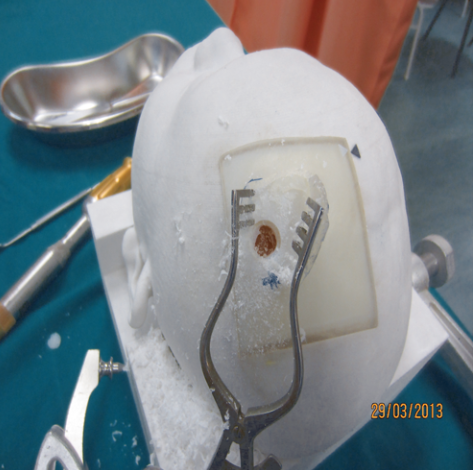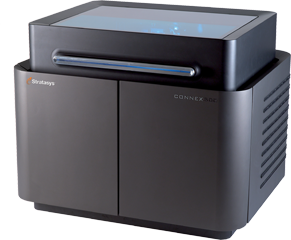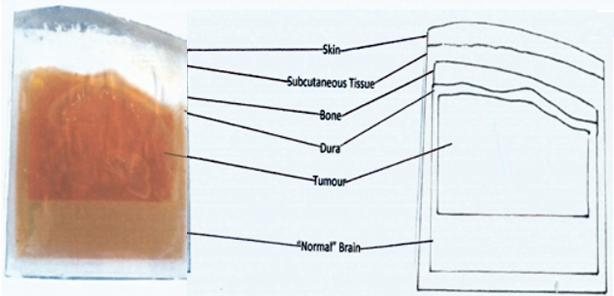Multi-material 3D printer creates realistic neurosurgical models for training
December 12, 2013
[+]
Researchers* from Malaysia and the UK have used a new multi-material
3D printer to create realistic, low-cost model of the skull for use by
students in practicing neurosurgical techniques.
A
model of a skull, showing a burr hole. Produced using a multi-material
3D printer, it’s composed of a variety of materials that simulate the
various consistencies and densities of human tissues encountered during
neurosurgery. (Credit: American Association of Neurosurgeons)
The model uses a variety of materials that simulate the various consistencies and densities of human tissues encountered during neurosurgery.
Neurosurgery is a difficult discipline to master. Trainees may spend as many as 10 years after graduation from medical school developing and honing their surgical skills before they can be designated as proficient in their specialty. The greater the number and variety of neurosurgical training sessions, the better the training experience.
However, the researchers say, it’s difficult to find suitable simulation models that offer accuracy and realism for neurosurgical training while keeping training costs down.
Three-dimensional printers have been used to create models of normal and pathological human tissues and organs for physician training and patient instruction for some time. Until recently, however, only one material could be used in the creation of models, which is of little value for hands-on training.
With the advent of multi-material 3D printers, the sophistication and versatility of the new models that could be created increased substantially, but so did their price. Now the newest multi-material 3D printers are available at lower prices.
Realistic look and feel
[+]
With the aid of a Stratasys Objet500 Connex multi-material 3D
printer, researchers at the University of Malaya created a two-part
model that can simulate pathological conditions in actual patients.
Stratasys Objet500 Connex 3D multi-material printer
The base piece of the model (the “head”) consists of one material. It has human features (a “face”) and the natural contours of a human skull. This piece is used to train the novice in neuronavigation techniques and can be reused again and again.
The second part of the model defines the region in which simulated surgery is performed. This piece contains several different materials, which separately simulate skin, bone, dura mater, tumor, and normal brain tissue.
The second piece fits into a slot in the base piece; this multi-textured piece can only be used once and is discarded after the practice session. Fortunately, it is easy to reproduce a steady stream of new pieces.
To make the training session valuable, the trainee must be able to see, feel, and even hear different “tissue” responses to surgical instruments and techniques during simulation surgery. The researchers say the “skin” is designed to be pliable enough to be cut by a scalpel and repaired by sutures, yet sturdy enough to be held by a retractor; the “bone” has to be hard enough for the trainee to obtain experience using bone perforators and cutters; and the “dura mater” must be thin and pliable — just like the real thing.
[+]
The consistency and color of the “tumor” (softer than the “brain” and
colored orange) was also different from those of the “brain” (light
yellow) to simulate actual tissues.
Cross-sectional
view of model with tumor and a drawing delineating parts of the model
(credit: American Association of Neurosurgeons)
According to Dr. Vicknes Waran, first author of the Journal of Neurosurgery paper, the reusable base piece of the model costs approximately US $2000 to fabricate and the disposable inset costs US $600. This makes these training models affordable. And model designs are based on actual patient data, providing limitless variety.
“As 3D printer technology improves, these machines will provide the possibility for newer, more complex models to be created, allowing an improved training experience,”said Waran. “3D models of the future may allow the possibility to perform entire operations from start to finish, making for a realistic simulator to be used in neurosurgical training.”
Customized models
In addition, “this technique allows multiple surgeons to be trained simultaneously to carry out actual operations,” Waran explained to KurzweilAI. “These models are also being created prior to complex operations to allow surgeons to plan and carry out simulation surgery prior to an performing the actual procedure.
“These models are customized. They are made based on actual patient imaging data, therefore they have pathology. Following customization the models are replicated and as they are accurate, surgeons can perform operations to familiarize themselves to complex and simple procedures. All models come with a story and images, adding an important dimension for realism. This is especially useful when trying to train persons to deal with uncommon problems as an entire operation.”
“Using these models also allows surgeons to use the actual tools that they would be using in an actual operations. This adds important cost savings. Presently, most training is conducted on cadavers that require special instruments and also lack any pathology.
As for availability, “presently, the models are available through a commercialized unit of the university, which can create models for persons conducting workshops for training of surgeons. We have began running regular worksjops using these models. And certain multinationals have been using these models to conduct their own training program for surgeons in the Asia Pacific region and their own personnel.”
* University of Malaya in Malaysia, University of Portsmouth, and University of Oxford
Abstract of Journal of Neurosurgery paper
The advent of multi-material 3D printers allows the creation of neurosurgical models of a more realistic nature, mimicking real tissues. The authors used the latest generation of 3D printer to create a model, with an inbuilt pathological entity, of varying consistency and density. Using this model the authors were able to take trainees through the basic steps, from navigation and planning of skin flap to performing initial steps in a craniotomy and simple tumor excision. As the technology advances, models of this nature may be able to supplement the training of neurosurgeons in a simulated operating theater environment, thus improving the training experience.
(¯`*• Global Source and/or more resources at http://goo.gl/zvSV7 │ www.Future-Observatory.blogspot.com and on LinkeIn Group's "Becoming Aware of the Futures" at http://goo.gl/8qKBbK │ @SciCzar │ Point of Contact: www.linkedin.com/in/AndresAgostini
 Washington
Washington